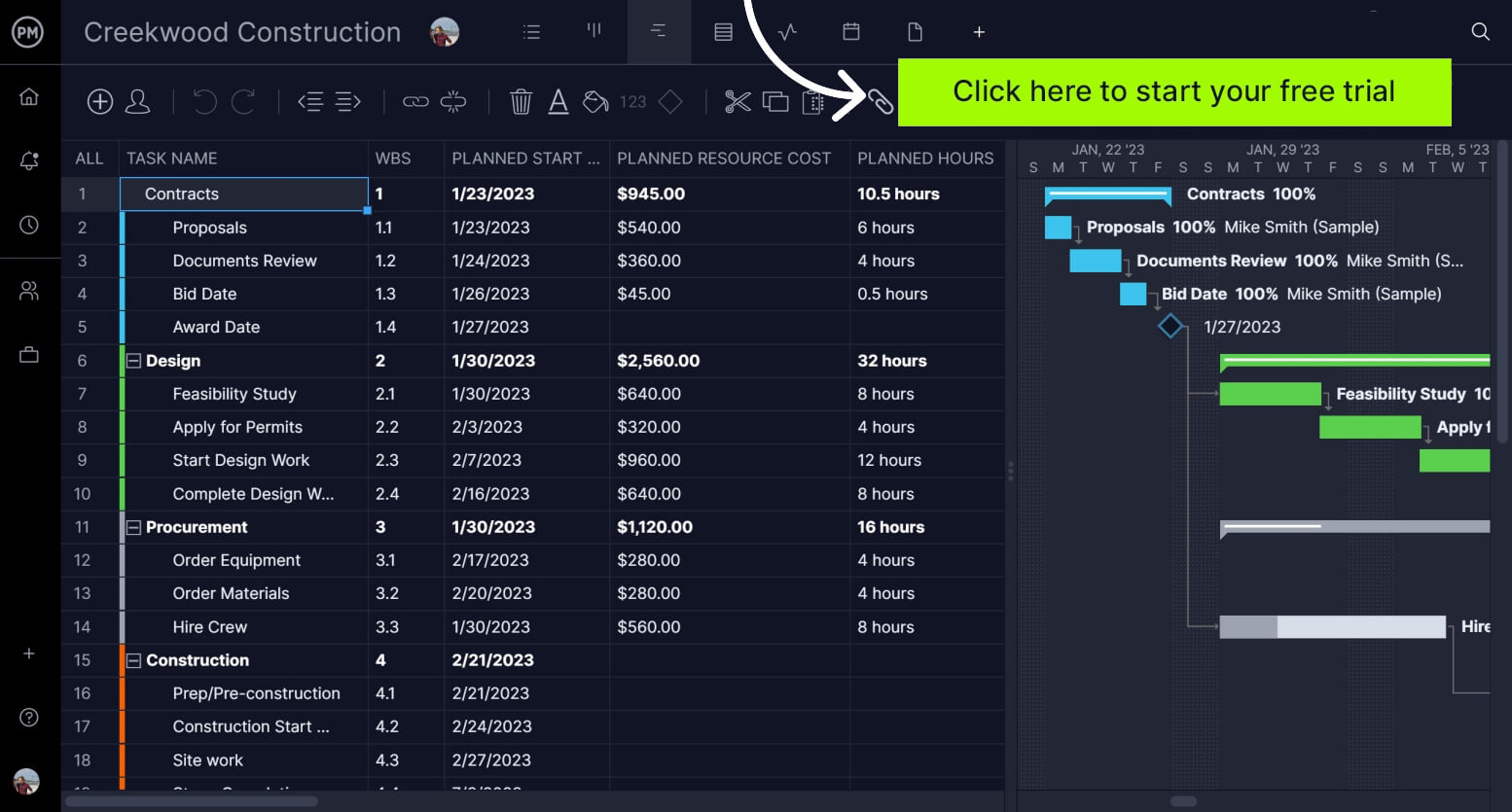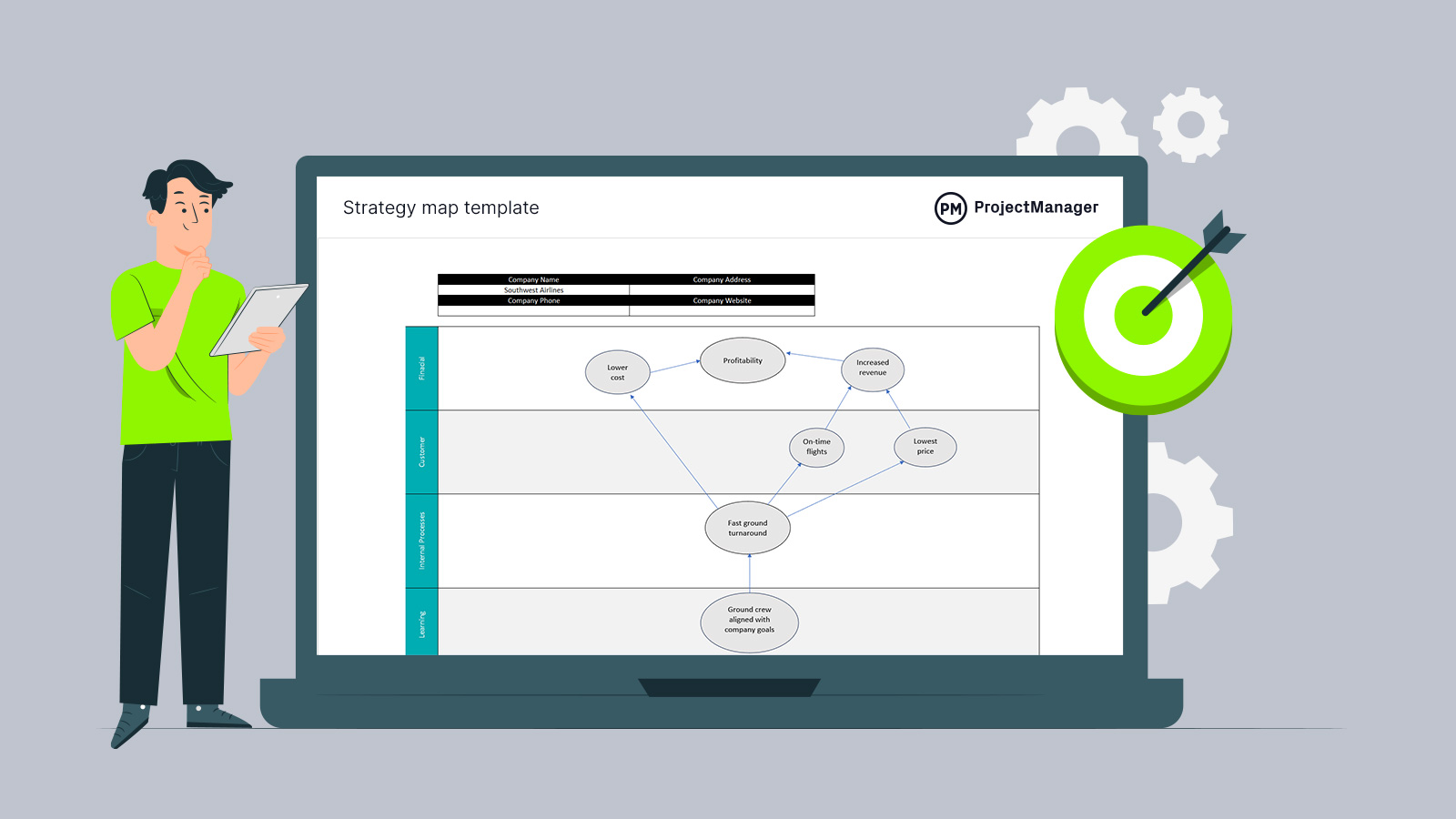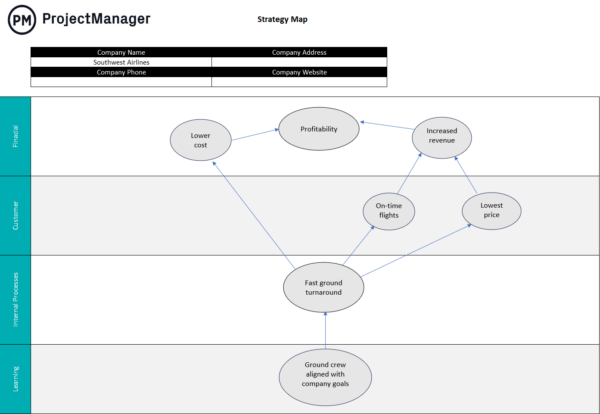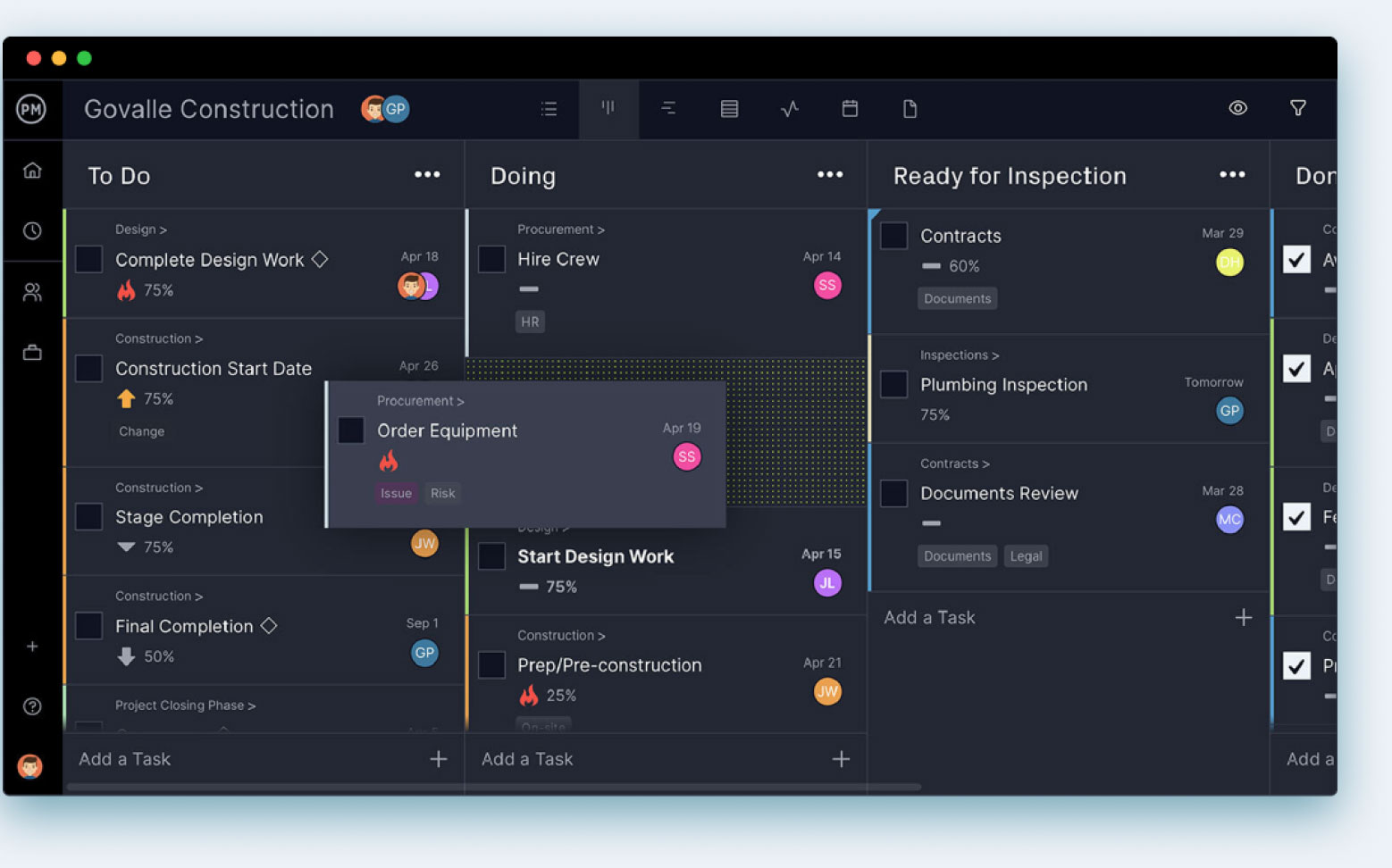Any organization, whether for-profit or not-for-profit, even governmental agencies, all have something in common. That is, they all develop strategic plans to achieve long-term goals to create value. To communicate this, organizations will usually employ what is called a strategy map.
If you’re unfamiliar with a strategic map, we’ll explain what it is and what is included in one. Then we’ll provide an example to better illustrate what we’re talking about and even provide a download to a free strategy map template to help you get started.
What Is a Strategy Map?
A strategy map is a simple graphic that illustrates the logical, cause-and-effect relationships between the strategic objectives of an organization, which are typically defined in its strategic plan. Those strategic objectives are represented on the strategy map as ovals placed on one of the four rows that show the areas in which these strategic objectives are to be achieved.
The strategy map is part of the larger balanced scorecard methodology and is used as a way to quickly and effectively communicate strategic objectives and how they will create value for the organization. This is especially helpful for the visual learners in your organization. The strategic goals will be communicated several ways, such as documentation and meetings, but often the most effective tool is the visual strategic map.
Once the strategic plan is clear across the entire organization, project management software will help plan, manage and track those projects to successful completion. ProjectManager is award-winning project and portfolio management software that helps you create timelines and budgets for your organization’s projects and processes.
Use our powerful Gantt charts to create visual timelines and allow you to organize tasks with costs and resources. All four types of dependent tasks can be linked to avoid costly delays and it’s easy to filter for the critical path to identify essential tasks. Once you have a schedule and budget, set the baseline and you’ll be able to track planned progress and costs against actual progress and costs to help you meet deadlines and not overspend. Get started with ProjectManager today for free.

What Should Be Included in a Strategy Map?
The strategic map has four rows on which are placed ovals with directional arrows. There are also your strategic objectives that are plotted across these rows. Let’s define each of these elements that make up the strategy map.
Strategic Objectives
Strategic objectives are represented on the strategy map by ovals in which the strategic objective is defined. A strategy map is usually limited to 15 or fewer strategic goals so that it focuses on the most vital drivers of your organization’s success. There will be strategic objectives for each of the four perspectives on the strategy map. Those four perspectives are represented as rows on the strategy map and are defined below.
Financial Perspective
The financial strategy of an organization is usually measured by revenue growth and productivity. If you’re a nonprofit organization or municipality, then you’d top your strategy map with your mission rather than financials.
Customer Perspective
Customers should be at the center of your strategy and thus it appears on the strategy map after the financial perspective. If you’re a for-profit organization, then the value proposition can be one of the following: product leadership, customer intimacy or operational excellence. It’s up to you to decide which of these three customer perspectives has the most weight as focusing on all three equally is unrealistic. If you’re a nonprofit organization or governmental agency, the beneficiaries or citizens would replace customers. Your three value propositions would involve how you serve their needs.
Business Process Perspective
This is where you define how you’re going to achieve your financial and customer goals. It’s a matter of improving your internal business processes that support fostering growth through innovation and new-market expansion; enhancing customer value by improving relationships with existing customers; working towards operational excellence; and creating productive relationships with external stakeholders.
Learning & Growth Perspective
Here is where you explore how the employee skills and knowledge necessary to make the above processes run better, which will lead to providing value to your customers. This will then lead to improving your financial position. Specifically, many objectives can fit in this perspective depending on the organization and the goals you’ve outlined above.

Get your free
Strategy Map Template
Use this free Strategy Map Template for Excel to manage your projects better.
Strategy Map Example
Now, the definition of a strategy map should be clear as well as its parts and what they mean. To further illustrate what a strategy map is and how they work, let’s take a look at a real-life example. Southwest Airlines has a very clear and easy to understand strategy map.
Its financial objective is profitability, something all for-profit companies can relate to. It plans to achieve this financial goal by having lower costs and increased revenue. All of this would be illustrated in the financial perspective row of their strategy map.
In terms of the customer perspective, they want to have on-time flights, which leads to the financial goal of increased revenue due to more loyal and satisfied customers. But the other customer perspective they hope to achieve is lower prices for their customers.
This brings us to the business process perspective, which will allow Southwest Airlines to fulfill their objectives. Here they put one objective and it’s a fast ground turnaround. This will lead to lower prices, which in turn will create increased revenue and achieve their goal of profitability. It will also lead to lower costs, achieving profitability, and more on-time fights. That, too, feeds into the financial perspective.
Finally, the learning and growth perspective objective is to have its ground crew aligned with company goals. The strategy map will help to communicate that. Plus, the arrows on the strategy map will show how each objective influences the overall strategy in a simple and visual way. Through this Southwest Airlines is able to communicate its strategy and how it’s implemented.
Strategy Map Template
Building a strategy map is really just busy work. You can draw it on a piece of paper, but that’s not as easy to share across your organization. You can also create it in Excel, but that takes time and is hard for people not familiar with using spreadsheets. ProjectManager has a free strategy map template for Excel that you can use.
It’s one of the dozens of free project management templates for Word and Excel we have to download on our site. Download the free strategy map template for Excel and then all you have to do is fill in the blanks and share it with your organization to clearly communicate your strategic goals.

Strategy Map vs. Balanced Scorecard
We’ve already mentioned that a strategy map is part of the larger balanced scorecard methodology. Let’s explain better what that means. A strategic map is a visual representation of the balanced scorecard perspectives. These are the four perspectives we’ve already discussed: financial, customer, business process and learning and growth.
The balanced scorecard is more of a method, the strategic map is a diagram used in that method. Therefore, the strategy map is an element of the documentation associated with the balanced scorecard and shows the relationship between the drivers and the desired outcomes. The strategy map focuses on strategy and results.
Strategy Map vs. Strategic Roadmap
A strategic roadmap is the bridge between an organization’s strategy and its execution. Like a strategy map, it visualizes the strategy, but with different objectives. The strategy map shows drivers and outcomes. It’s used to communicate the strategic objectives of an organization to the people who are tasked with achieving those goals.
A strategic roadmap is used to show the key outcomes that must be delivered over a particular time frame in order for the organization to reach its goals. Therefore, it’s more of a bird’s-eye view of the organization’s direction, showing where it currently stands and where it wants to be over a period of time. It’s more detailed than a strategy map as it shows key strategic goals, initiatives and timelines, highlighting dependencies and potential obstacles.
Benefits of Using a Strategy Map
There are many reasons for using a strategy map. Just as you use a map to get you physically from one place to another you’ve not been to before, a strategy map will guide you to that destination. Without a strategy map, you’re blind. Here are some reasons why you should use a strategy map.
Helps Visualize the Strategic Objectives
The strategy map is a visual tool that communicates your strategic objectives to the organization that is tasked with achieving them. It is easy to understand at a glance, which is important and facilitates the process of developing action plans for each of the business departments of an organization. You want your team to know what they’re working on and why they’re working on it. But the strategy map also shows the various connections between the objectives and how they drive outcomes. It does this through the directional arrows, which makes it easier to digest.
Helps Track Performance
Another benefit of using a strategy map is that it includes key performance indicators (KPIs) to measure each objective and will allow your organization to track performance from multiple perspectives. By linking objectives to performance measures, your strategy map helps you have specific, measurable and actionable objectives.
Facilitates the Strategic Planning Process
The strategy map helps to visualize goals and targets while considering different perspectives. This helps with the strategic planning process by offering a sense of direction and outlining measurable goals. The strategy plan can also expose gaps in your strategic planning process before you set anything in motion and it’s harder to change.
How ProjectManager Helps With Strategy Mapping
The strategy plan visualizes your strategic objectives, but project management software is what allows you to take action to achieve them. ProjectManager is award-winning project and portfolio management software that can help you plan, manage and track your strategic plans in real time to better ensure they’re delivered on time and within your budget. Our software has features to help you with your team’s workflows and resources.
Manage Tasks and Workflows Across Teams and Departments
Because we have multiple project views, including Gantt charts, kanban boards, task lists, sheet and calendar views, teams can work with the tools they’re most comfortable with. All our project views update together in real time, so everyone is always working on the same up-to-date data. We even have automated workflows to streamline your processes. There are triggers you can set to automate actions for repeatable or common tasks to keep teams focused on more important work. Plus, you can set up task approvals to ensure quality.

Track Resource Allocation and Costs
You can plan human and nonhuman resources on our Gantt charts and set availability to make it easier to see who is on vacation, has PTO and if there are any global holidays for your remote teams to help when making assignments. Then use the color-coded workload chart to see who is overallocated and reallocate resources right from that chart to balance your team’s workload and keep them working at capacity. Track labor costs with our secure timesheets, which streamline payroll, but also show how much you are spending on your team and how far they are on their tasks.

Related Strategy Content
If you’re still looking for more articles on strategic planning and related subjects, we have many more pieces of content linked below. Our site is an online hub for all things project management, including our powerful software, but also weekly blogs, tutorial videos and free templates. Here are some links for you to follow for more information.
- Strategic Project Management: Planning Strategic Projects
- Strategic Planning in Business
- Strategic Plan Template for Word (Free Download)
- How to Create a Strategic Roadmap for Your Organization
- A Quick Guide to Strategic Initiatives
ProjectManager is cloud-based project and portfolio management software that connects teams in the office, out in the field and anywhere else in the world. Teams can share files, comment at the task level and stay updated with email and in-app notifications. Join teams at Avis, Nestle and Siemens who use our software to deliver successful projects. Get started with ProjectManager today for free.



